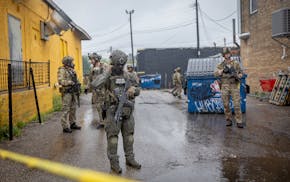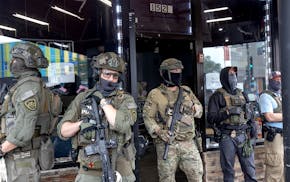ST. CLOUD – On Tuesday, St. Cloud voters will be asked to make decisions on a new fire station and moving city elections to odd years, and — for those who live in Stearns County — how to fund a new county jail.
Here's a look at the three referendum questions that are on St. Cloud-area ballots this year.
Sales tax for Stearns County justice center
Ballot question: "Shall Stearns County be authorized to impose a sales tax & use tax of three-eighths of one percent to finance up to $325 million, plus associated bonding costs, for the construction of a justice center facility, consisting of law enforcement, judicial center and jail? The sales tax would be used solely to finance construction, upgrades and financing costs for the justice center and remain in effect for 30 years or until the project is paid for, whichever comes first. These services and facilities are mandated by the state of Minnesota to be provided by counties."
Stearns County officials are planning to build a new $325 million justice center complex that includes a 270-bed jail, a judicial center with courtrooms, and a law enforcement center that houses the Sheriff's Office. In the summer, Stearns County board members voted to move those facilities out of downtown and to a new location with more space. That site has yet to be determined.
The question before voters is how to fund that center.
County Administrator Mike Williams said a common misconception he's heard at recent town halls is residents think voting "yes" gives permission to the county to build the facility, and if they vote "no," the county won't spend the money to build it.
"People [think they] are voting on the project — and they're not. They're voting on how we are going to fund it," Williams said.
If voters approve the ballot question, the county will impose a sales tax to fund the project. If they vote it down, the county can instead pay for the project with property taxes.
Because sales tax is collected from residents and nonresidents who spend money in the county, the project's cost for county residents will likely be less with the sales tax, Williams said. Officials estimate the sales tax would cost a Stearns County household about $85 a year, and the annual cost if paid for with property taxes would be about $185 per household.
County leaders have known the current downtown jail was cramped and nearing the end of its useful life for more than a decade. And for many years, the county has been paying to house inmates in other facilities because the jail is overcapacity. Officials also have safety concerns about the current courtroom facilities.
When the new justice center is built, the county will likely raze the existing jail and the court building that's just west of the jail, but will continue to use the downtown administration building. The historic courthouse will not be torn down, Williams said.
Tax increase for new fire station
Ballot question: "Shall the city of St. Cloud, Minnesota be authorized to issue general obligation bonds in the principal amount of up to $43.5 million for the acquisition and betterment of critical public safety facilities, including the construction and equipping of a new fire station? By voting "yes" on this ballot question, you are voting for a property tax increase."
St. Cloud officials are asking residents to approve raising property taxes to fund a new $43.5 million fire station on the city's southwest side. The monthly tax impact for an average house in St. Cloud valued at $235,000 would be $9.
The city has five fire stations, one of which is used only to support airport operations. The city's last new fire station — just north of I-94 on the city's south side — opened in 2008 after voters approved a tax increase for the project.
The new station would provide fire and emergency service to an area that has seen recent growth, including the new Tech High School, charter schools and growing residential neighborhoods.
"That area [has the] longest response times in the entire city — and when you drive through that area, you see thousands of students in four or five different schools, you see apartments going up," said St. Cloud Fire Chief Matt Love. "What makes a fire chief lose sleep at night? Thousands of kids farthest away from a fire station."
The new station would also include a training center for responders in St. Cloud and surrounding communities. The planned site is on a prominent east-west road and is just east of Hwy. 15, which allows for quick access into the denser parts of the city.
"The biggest thing I hope people understand is even though you don't live where this new station is going in, it affects response times across the whole city," Love said. "This affects you even if you live on the other side of the city because we're not pulling those resources from as far away."
Love said the department is slated to run 10,000 calls this year, a rise of 32% from four years ago. If approved, the new station would likely open in 2027.
Charter change to odd-year elections
Ballot question: "Shall the City Charter be amended to provide that the regular municipal election be conducted on odd numbered years commencing in 2029? The terms of the mayor and council members elected in 2026 and 2028 shall be for three years to align with city elections in odd numbered years."
St. Cloud voters are being asked if they want to amend the City Charter so elections are held on odd years — similar to how it's done in Duluth and Minneapolis, and how it used to be done in St. Cloud.
Mayor Dave Kleis suggested the change to prevent the mayor and City Council seats from being overshadowed by state and national races. He said while it's true more people vote overall in even-year elections, their votes are for the state and federal races and not always the local races. By having city elections in odd years, Kleis said, the voters who do go to the polls will likely be more informed on the candidates and issues.
"The most important election that has the [largest] effect on anybody living in our community on a day-to-day basis is local," Kleis said in July. "Your sewer, your water, your public safety is all a local issue."
About two decades ago, St. Cloud voters approved moving city elections from odd years to the current even-year system as a way to save the city money.
Kleis was first elected during an odd-year election in 2005, when only about 30% of registered voters cast a ballot, according to St. Cloud Times archives.
City records show voter turnout increased during even-year elections, though there were drop-offs in votes for local races. In 2012, during a presidential race, 72% of registered voters in St. Cloud went to the polls but only 56% of registered voters cast a vote in the uncontested mayor race. In 2020, during a presidential race and contested mayor race, about 80% of registered voters went to the polls and about 72% voted in the mayor race.
If St. Cloud's city elections are moved to odd years, turnout would likely dip. In Duluth, mayoral elections over the past two decades have garnered voter turnout percentages ranging from about 38% to 56%, according to the Duluth News Tribune. And in Minneapolis, about 80% of registered voters went to the polls for the last presidential election but only 32% voted in last year's mayor race, according to the city.

Federal operation at Lake Street restaurant that drew protests was one of 8 across Twin Cities

MPCA intends to yank permit for St. Paul foundry accused of polluting the neighborhood

In surprise testimony, brother says Derrick Thompson was driving in crash that killed 5 Somali women

Their faces covered during Minneapolis raid, federal agents raise privacy worries

